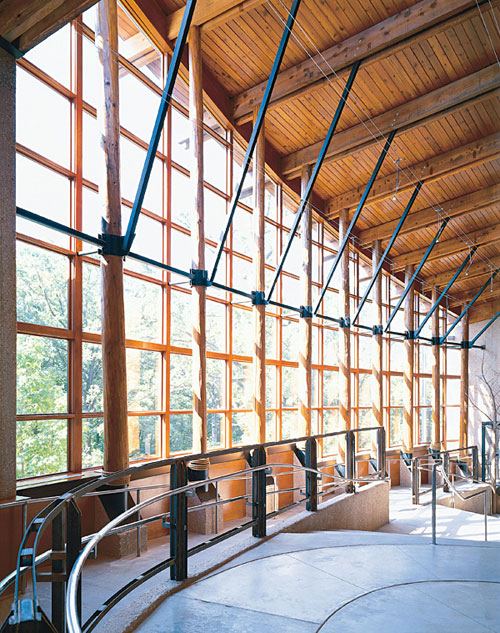Daylight Savings: Window Systems Deliver Light and Reduced Energy Costs
Windows and Daylighting
 |
At the Lakeside Nature Center in Kansas City, Missouri, floor-to-ceiling glazing rises 28 feet to promote daylighting and enhance the feeling of being in nature. International Architects Atelier. Lakeside Nature Center, Kansas City, MO; International Architects Atelier; Courtesy of Pella Corporation |
Â
"The central challenge of effective daylighting design is allowing natural light to penetrate deep into interior spaces, while eliminating glare and heat gain or loss," says Jeff Razwick, vice president of Technical Glass Products (TGP), a supplier of fire-rated glass, framing systems and specialty architectural glass products. It's also important to ensure that the light admitted to the building's interior is high-quality, spectrally neutral and, ideally, integrated with the electric lighting design. Daylighting strategies contribute to earning U.S. Green Building Council Leadership in Energy and Environmental Design (LEED) points in four of the six categories: Indoor Environmental Quality, Energy and Atmosphere, Materials and Resources, and Innovation and Design Process.
 |
High performance Low-E glass was specified for the Frank Gehrydesigned Art Gallery of Ontario. ©2009 Art Gallery of Ontario; Photography: Sean Weaver; Courtesy of Guardian Industries Corp. |
Â
What effective daylighting does not mean is merely increasing the number of windows in a building. "A lot of confusion revolves around the appropriate level of light," says Chris Dolan, Director of Commercial Glass Programs at Guardian Industries Corp., manufacturers of float glass and coated glass products. "More windows do not automatically equal more daylighting." According to the Daylight Collaborative in Wisconsin, the sun provides 7,000 to 10,000 foot-candles of light, while indoor office spaces need only about 50 foot-candles. Too much light causes glare, encouraging people to close the blinds and turn on the lights, which is obviously a counter-productive move.
"One of the most common failures in daylighting strategies today is glare control," says Terry Zeimetz, AIA, CSI, CCPR, Commercial Marketing Manager at Pella Corporation. "Large window areas provide generous amounts of daylight to the task area, but if it's not properly regulated glare results, particularly in today's computer environments."









